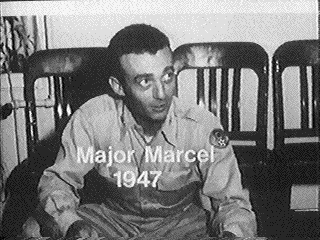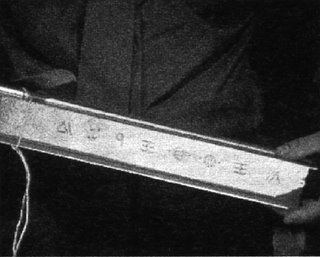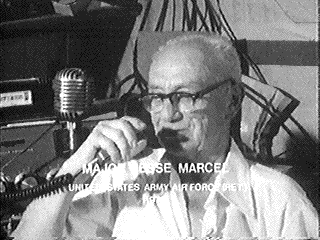
|
Roswell
Debris Field - Timeline
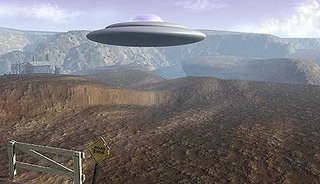 Roswell Citizens Threatened The Roswell Aliens Roswell Main Crash Site Roswell EyewitnessesRoswell Timeline The Debris Field This is the second
site, the one that most people think
of when they talk about Saturday, July 5, 1947 Early in the morning William (Mac) Brazel rides out on horseback across the Foster Ranch to check on the livestock following the previous night' s thunderstorm. He is accompanied by seven-year-old William D. Proctor. Young Proctor goes along because he likes to ride horses. On a minor point, some reports refer to Brazel as the foreman of the ranch; some call him the owner. When they arrive at the site, they discover a large amount of strange debris strewn across the range. There is so much of it that the sheep will not walk through it. They end up having to herd the sheep almost a mile around it to get them to water. The debris consists of pieces of lightweight material that resemble tinfoil and pieces of very light I-beams with unknown symbols engraved in their sides. The debris is so unusual that Brazel gathers up a bunch of it and takes it home. Stanton Friedman interviewed many witnesses who actually handled the material. Here is how they described it to Friedman: "Something on the order of tinfoil, except (it) wouldn' t tear, you could wrinkle it and it lay it back down and it immediately resumed its original shape. It was pliable but wouldn' t break, weighed nothing, but you couldn' t scratch it with your fingernail." William Brazel (Mac Brazel' s son) "(Mac) had this piece of material he had picked up. He wanted to show it to us and wanted us to go down and see the rest of the debris or whatever. We cut on it with a knife and would hold a match on it and it wouldn' t burn." Loretta Proctor ( William D. Proctor' s mother) "Some of these pieces had something like numbers and lettering on them, but there were no words we were able to make out. The figures were written out like you would write numbers in columns, but they didn' t look like the numbers we use, at all." Mrs. Besie Brazel Schreiber ( Mac Brazel' s daughter) "Very much like tinfoil in appearance, but could not be torn or cut at all É extremely light in weight. Some small beams that appeared to be either wood or wood-like had a sort of writing on it which looked like numbers which had either been added or multiplied (in columns)." Walt Whitmore Jr. ( Son of the owner of Roswell Radio station KGFL) Sunday July 6, 1947 Rancher Mac Brazel takes a box load (load #1; remember this fact) of the debris to county sheriff George Wilcox. This involves a trip of over seventy-five miles on unpaved roads, taking more than four hours. The only reason Brazel made the long trip was to deliver this strange material to Wilcox. After seeing the debris Wilcox decides it is strange enough that he should call the air base. He calls and speaks to Major Jesse Marcel, the Roswell Army Air Base intelligence officer. Shortly thereafter Marcel was ordered by Base Commander William Blanchard to go out to the ranch with Brazel and take a look around. This was a major endeavor (no pun intended); it' s a four-hour trip. All for a weather balloon? Major Marcel was accompanied by Sheridan Cavitt, who was an officer with the Counter Intelligence Corps. The men each drove separate cars. It was nightfall when they arrived at Brazel' s ranch. They spent that night at the ranch in a small cottage. 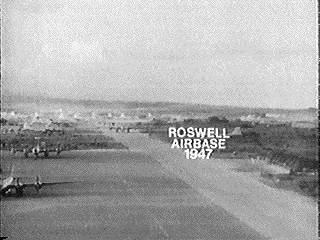 Roswell Army Air Base in 1947 Back at the Base While Marcel and Cavitt are heading out to Brazel' s ranch the following events occur: Colonel William
Blanchard, who is the Roswell Army Air
Base commanding officer and Commander of the 509th Bomber Squadron, is
given an
order by Major General Clements McMullen, Commander of the Strategic
Air
Command. McMullen tells Blanchard to retrieve some of the debris in
Sheriff
Wilcox' s possession and send it immediately to Colonel Thomas DuBose
at the
Fort Worth Army Air Field. The pieces of debris are sealed in a special
courier
pouch and flown to At Fort Worth Army Air
Field the plane carrying the pouch
is met personally by Colonel Alan D. Clark, the Base Commander. Monday, July 7, 1947 Brazel takes Marcel and Cavitt to the site of the debris field early in the morning. Debris is spread over a large area, estimated to be at least a square mile. Both men fill their cars with debris. One of the cars was a Jeep Carry-All, a kind of old-fashioned station wagon that Jeep used to make. Note: Marcel and Cavitt' s two loads, when combined with the load Brazel took to Sheriff Wilcox, have already totaled three car-loads of debris. The biggest weather balloon ever used by the military at that time would easily fit into one box the size of a 19-inch television. So drop the weather balloon bit, right now! In an interview that Jesse Marcel gave as a retired Colonel in 1979, he stated what he saw when he and Cavitt first arrived at the debris field: "When we arrived at the crash site it was amazing to see the vast amount of area it covered É scattered over an area of about three-quarters of a mile long, I would say, and fairly wide, several hundred feet wide. So we proceeded to pick up all the fragments we could find and load up our Jeep Carry-All. It was quite obvious to me, (my) familiarity with air activities, that it was not a weather balloon, nor was it an airplane or a missile. It was something I had never seen before, and I was pretty familiar with all air activities. We loaded up the Carry-All, but I wasn' t satisfied. I told Cavitt, "You drive this vehicle back to the base and I' ll go back out there and pick up as much as I can put in the car," which I did. But, we only picked up a small portion of the material that was there."
Major Jesse Marcel in 1947 Marcel held the rank of Major at this time. World War II had just ended two years before. These were career military men who saw weather balloons everyday. Simply look at their behavior in this debris field. This was no weather balloon! Marcel and Cavitt head back to the base. Major Marcel is impressed enough by the recovered material that he makes a special side trip to his house on the way back. He arrives at 2:00 a.m. (early Tuesday morning). It' s late at night but he wakes his wife and eleven-year-old son Jesse Jr. to show them the material. Here is part of Major Marcel' s firsthand description of the material he showed his family: "A lot of it had a lot of little members with symbols that we had to call them hieroglyphics because I could not interpret them, they could not be read, they were just symbols. Those symbols were pink and purple, uh lavender. I even tried to burn that. It would not burn." "But something that is
more astonishing is that the piece
of metal that we brought back was so thin, just like tinfoil in a pack
of
cigarette paper. So I tried to bend the stuff, it wouldn' t bend. We
even
tried making a dent in it with a sixteen-pound sledgehammer. And, there
was
still no dent in it."
Eleven-year-old Jesse
Marcel Jr. grows up to become a
surgeon, a pilot, and a colonel in the military. He also becomes an
experienced
airplane crash investigator as well as Surgeon General for the State of
Major Jesse Marcel Sr. in later years.
|
